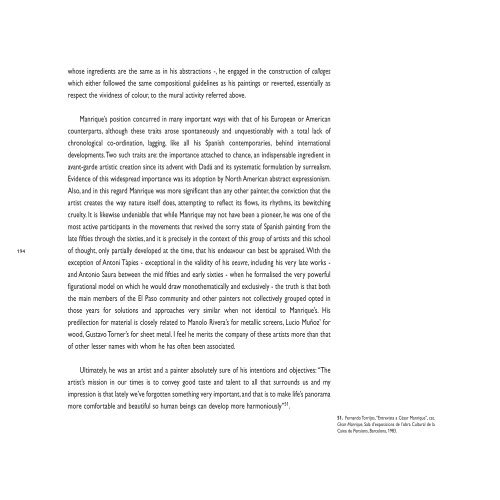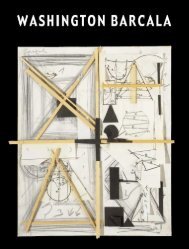VERSIÓN INGLESA ENGLISH VERSION - Fundación César Manrique
VERSIÓN INGLESA ENGLISH VERSION - Fundación César Manrique
VERSIÓN INGLESA ENGLISH VERSION - Fundación César Manrique
Create successful ePaper yourself
Turn your PDF publications into a flip-book with our unique Google optimized e-Paper software.
194<br />
whose ingredients are the same as in his abstractions -, he engaged in the construction of collages<br />
which either followed the same compositional guidelines as his paintings or reverted, essentially as<br />
respect the vividness of colour, to the mural activity referred above.<br />
<strong>Manrique</strong>’s position concurred in many important ways with that of his European or American<br />
counterparts, although these traits arose spontaneously and unquestionably with a total lack of<br />
chronological co-ordination, lagging, like all his Spanish contemporaries, behind international<br />
developments. Two such traits are: the importance attached to chance, an indispensable ingredient in<br />
avant-garde artistic creation since its advent with Dadá and its systematic formulation by surrealism.<br />
Evidence of this widespread importance was its adoption by North American abstract expressionism.<br />
Also, and in this regard <strong>Manrique</strong> was more significant than any other painter, the conviction that the<br />
artist creates the way nature itself does, attempting to reflect its flows, its rhythms, its bewitching<br />
cruelty. It is likewise undeniable that while <strong>Manrique</strong> may not have been a pioneer, he was one of the<br />
most active participants in the movements that revived the sorry state of Spanish painting from the<br />
late fifties through the sixties, and it is precisely in the context of this group of artists and this school<br />
of thought, only partially developed at the time, that his endeavour can best be appraised. With the<br />
exception of Antoni Tàpies - exceptional in the validity of his oeuvre, including his very late works -<br />
and Antonio Saura between the mid fifties and early sixties - when he formalised the very powerful<br />
figurational model on which he would draw monothematically and exclusively - the truth is that both<br />
the main members of the El Paso community and other painters not collectively grouped opted in<br />
those years for solutions and approaches very similar when not identical to <strong>Manrique</strong>’s. His<br />
predilection for material is closely related to Manolo Rivera’s for metallic screens, Lucio Muñoz’ for<br />
wood, Gustavo Torner’s for sheet metal. I feel he merits the company of these artists more than that<br />
of other lesser names with whom he has often been associated.<br />
Ultimately, he was an artist and a painter absolutely sure of his intentions and objectives: “The<br />
artist’s mission in our times is to convey good taste and talent to all that surrounds us and my<br />
impression is that lately we’ve forgotten something very important, and that is to make life’s panorama<br />
more comfortable and beautiful so human beings can develop more harmoniously” 51 .<br />
51. Fernando Torrijos, “Entrevista a <strong>César</strong> <strong>Manrique</strong>”, cat.<br />
<strong>César</strong> <strong>Manrique</strong>, Sala d’exposicions de l’obra Cultural de la<br />
Caixa de Pensions, Barcelona, 1983.
















![Becas y premios de la Fundación César Manrique [1997-2006]](https://img.yumpu.com/20766851/1/184x260/becas-y-premios-de-la-fundacion-cesar-manrique-1997-2006.jpg?quality=85)
